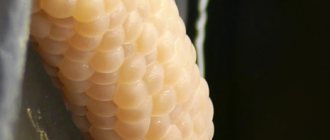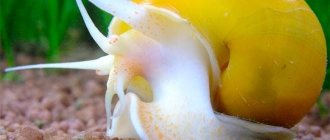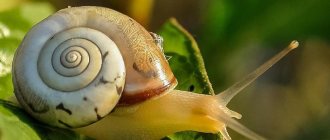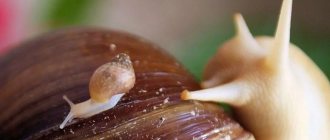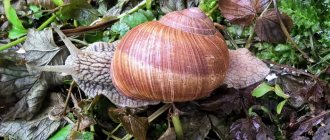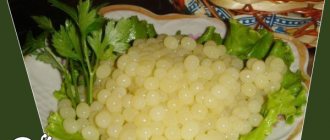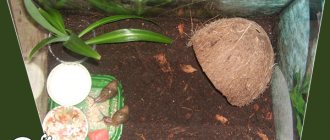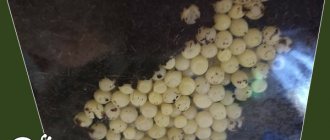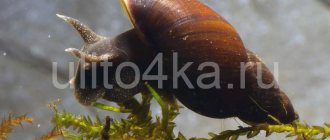Snails, or gastropods, are the most numerous class of mollusks, numbering more than 100 thousand species. A common characteristic feature for all varieties of the class is the presence of an external shell, the size of which allows all the soft parts of the body to be hidden inside.
It is believed that the name “snail” comes from the Proto-Slavic word “hollow”. Due to its relatively small size and special body structure, the question often arises: is a snail an animal or an insect? In the biological classification, all varieties of snails are classified as mollusks, which, in turn, belong to the animal kingdom.
Description and general characteristics of the snail
Tiara
Initially, gastropods were adapted to life in salt water. In the process of evolution, numerous species have appeared living in freshwater bodies and on land. Currently, all representatives of the class are divided into three main groups:
| Group | Habitats |
| Land snails | They lead a terrestrial lifestyle, preferring places with high levels of humidity. Land-dwelling species breathe air. |
| Water snails | Marine, lake and river mollusks that receive oxygen by passing water through their gills. |
| Pulmonary snails | They can be found on land and in water, periodically rising to the surface to breathe. |
The anatomy of gastropods has the following features:
- The main characteristic of snails is torsion. This is called turning the internal sac 180 degrees.
- The nervous system is of a scattered-nodular type. The brain and most of the elements of the system are located in the front of the body.
- The digestive system includes the mouth, crop, stomach, and digestive gland. Due to torsion, the anus is located in the anterior part of the shell.
- Most species have only one kidney.
What does it look like
Grape snail
The external structure of the snail includes:
- Carapace . It is an exoskeleton that is shaped like a cone, spiral, or coil. The shell consists of several organic layers covered with a durable outer layer of calcium carbonate. Mollusks without shells are called slugs.
- head is horned due to two pairs of tentacles located on the head. The two long horns are the eyes (at the ends there are eye spots), and the two shorter ones are the olfactory organs. Mollusks see poorly and use their sense of smell and touch primarily for orientation.
- Leg . The main part of the body expands downward, forming the so-called ventral foot.
Sadovaya
How fast does a snail move?
There is a generally accepted belief that mollusks are the slowest creatures. How fair is this?
Snails move thanks to muscle contractions of the leg. In this case, intensive secretion of secretion from the mucous gland occurs. Mucus allows you to crawl faster on horizontal surfaces and provides reliable grip on surfaces when moving vertically.
Some snails move by crawling, others tear off part of their leg, alternately transferring the center of gravity from the front to the back and vice versa, resembling a caterpillar.
The speed of a gastropod depends on the method of movement, species, and living conditions. Thus, amber snails cover only 1-2 cm per minute, grape snails - 7 cm, trumpeter snails - 16 cm. Mollusks living in rivers and seas are capable of developing much higher speeds than their land-based relatives. The fastest of the snails is the sea butterfly. It is capable of speeds of up to 12 m per minute thanks to two wing-like blades formed during the transformation of the leg.
Natural enemies
To combat overgrown snails, fish are used... Or another type of snail. Yes, there are predatory mollusks that eat smaller relatives, for example, the Helena snail.
As for fish, tetradon, clown loach, macropod, gourami or catfish will help control or completely destroy the shellfish population.
The main thing is that when adding a predator, pay attention to whether it is able to get along with other fish and whether it will harm them. For example, tetradon and catfish can bite the fins of “peaceful” fish, and the clown loachfish becomes aggressive and can kill young animals of small breeds. As for the Helena snail, it is harmless to fish, but after exterminating the snails, it does not easily transition to regular food.
Types of snails
Neretina
The taxonomy of gastropods is periodically revised with the emergence of new data on the origin and development features of representatives of the class. The latest version of the classification appeared in November 2021.
Below are short descriptions of the most common and interesting gastropod species:
- Grape snail . A medium-sized mollusk with a deep brown shell. Found in most European countries. Meat and caviar are considered a delicacy.
- Reel _ A freshwater aquatic snail that grows to a size of 1-3 cm. The surface of the shell is painted red. Coils are placed in aquariums to remove plaque on the walls and eat dead algae.
- Garden snail. A terrestrial herbivorous mollusk with a light brown shell. It is a pest because it destroys young shoots and fruits of many garden crops.
- Neretina . The mollusk is native to the African continent. The shell grows up to 3-4 cm in diameter and has several color options: brindle, olive, striped. These are common domestic snails that become a real decorative addition to the aquarium.
- Akhatina . The largest land mollusks with a conical shell that has a wide variety of shades. In regions with a temperate climate, it is suitable only for home breeding.
- Luzhanka . A small freshwater mollusk with a brownish-red or brownish-brown shell. Belongs to viviparous species. Distributed in the southern regions of the European continent.
- Forest snail (chain snail). The most common species in Europe. You can identify it by its yellow shell with black stripes.
- Ampularia . An unpretentious aquarium snail native to South America. In favorable conditions it can grow up to 10 cm in length.
- Bitinia . Lives in Europe, Asia and North America. The conical shell is painted dark brown. More than 20 subspecies of the mollusk are known.
- Tiara . An aquarium mollusk with small, needle-like hairs growing on its shell. The hairy snail reaches a length of 2-3 cm and has a yellow or cream color.
Achatina
How does caviar ripen?
A short period of time after laying, the eggs darken (shells form) and harden. Egg size is 2.5-3.5 mm.
The laid eggs can be left in the original aquarium or placed in another tank. To do this, the masonry is moistened with water and after 2 hours it is transferred to a new place. The water temperature during ripening is 19-28 degrees.
To prevent the caviar from drying out, it is moistened with water (sprayed from a spray bottle). It is important not to overdo it, otherwise the eggs will become moldy and die.
The underwater masonry must not be touched. It appears in the form of small eggs covered with yellow translucent mucus.
There are snails that create an incubator inside their shell. There, the laid eggs develop in complete safety until they leave the mother's body.
Habitat
The lifestyle of snails and the ability to adapt to different living conditions have allowed them to spread almost throughout the world, with the exception of polar and arid desert regions. In nature, the greatest diversity of species is represented in the tropical and subtropical zones.
Luzhanka
Mountain and grape snails are grown artificially on special farms for subsequent consumption and production of cosmetics.
Horned delicacy
Snail is an excellent dietary product: fat 1.7%, carbohydrates 14%, proteins 37%.
This is a third more than in chicken eggs. And absolutely no cholesterol. Shellfish are also rich in essential amino acids, which our body cannot synthesize on its own, as well as biologically active substances. The family loves the snail. Irina sifted through a lot of literature and compiled her own cookbook: what and how to cook from this shellfish. Therefore, it is not surprising that they see gastronomic tourism as one of their areas of activity. A barrel car with a kitchen, equipped in accordance with all sanitary rules, has already been installed.
It turns out that it is not enough to grow or catch a snail in the wild; it also needs to be properly prepared. Like any dish, it has its secrets. Before you cook shellfish, you need to thoroughly cleanse their intestines. To do this, Pavel transfers the gastropods under a canopy into mesh boxes for a week. And to make the process go even faster, water them with water every evening. After all, without food, a snail can hibernate, and cold water is a great invigorator.
The shellfish also need to be cooked properly. To make them tender and soft (and not rubbery), Irina dips them in cold water and cooks until they boil. As soon as foam appears, drain the water. By the way, filled with mucus, it is very useful for the stomach. Add pepper, onion, garlic, carrots, parsley root to the new water, add some salt (the snail will take as much salt as it needs) and cook for 25 minutes.
And then it all depends on the dish. You can, before the snail has cooled down, remove the meat from the shell and freeze it, so that you can then add it to absolutely any dish: cutlets, pasties, dumplings, fried potatoes, soup... Or you can fry the boiled snail in its shell in a frying pan or on the grill. It's more exotic to eat this way. The Stanislavchiks love to cook snails for themselves and their guests.
How long do snails live?
forest chain
The average lifespan of most gastropods is 4-5 years. Some land species live up to 8-10 years. The real long-livers among their relatives are the megas and the grape snail: in favorable conditions, some individuals are able to live up to 15-20 years.
SQUIRREL
How to determine the age of a snail
Ampoules
Mollusks change their appearance depending on the stage of development. First of all, when determining age, you should focus on the size of the shell and the number of turns in it. In some species, the reproductive organ becomes visible after puberty. You can find information that older individuals change their taste preferences or shell color. All known methods make it possible to establish the age of a mollusk only approximately. It is impossible to know exactly the number of years a snail has lived.
Aquarium fish that eat snails
Fish can also be carnivores. To control the population of pest snails, you can add fish to the aquarium that will feed on them. These include:
- Green puffer fish. It feeds on snails, but cannot be kept in an aquarium on a permanent basis. It requires brackish water. Pufferfish eat other fish, so they need to be kept in a separate aquarium.
- Clown fish and marbled loachfish. These fish also feed on snails, but they grow quite large. They can only be bred in large aquariums.
- Gold fish. They are often used to control snails in aquariums installed in pet stores. These fish are placed there for a while to reduce the population. They cannot be kept in a common aquarium on a permanent basis; they require a separate tank.
- Killer snails. These are not fish, but a type of mollusk that feeds on invertebrates. They hunt and eat smaller snails.
- Corey and other scavengers. These fish can be kept in a community tank if you want to get rid of all the snails. They do not eat adults, but feed on their eggs, which allows the population to quickly decline.
Before adding new fish to the aquarium, be sure to make sure that they will not harm the existing inhabitants.
How do snails winter in nature?
Most species of land snails that live in regions with seasonally low temperatures hibernate during the winter months. Wintering can begin as early as October and ends in April with the arrival of stable heat.
Before the start of the rest period, animals feed heavily, gaining weight and stocking up on nutrients. Next, the mollusks begin to prepare a place for wintering. Typically, shelter is provided by holes covered with leaves, or specially dug holes. During sleep, the snail seals the entrance to the shell with a mucus plug - the epiphragm.
During wintering, the mollusk's metabolic processes slow down, and the chemical composition of the hemolymph and intracellular fluid changes. This makes it possible to avoid frostbite and survive the cold, using the nutrients accumulated in the fall.
Some species may hibernate during drought or lack of food supply.
What to do with excess shellfish
To reduce the population of aquarium shellfish, you must:
- Use a special chemical. It can be purchased at a pet store. The product, according to the instructions, is poured into the aquarium and after a while the weak snails die. Only in this case you need to be careful, since other inhabitants of the aquarium may die along with the snails: any shrimp and some fish.
- Use electric current. This manipulation is performed by experienced delivery drivers; beginners may not be able to cope with the task.
- You can have Helena. It is known for eating other shellfish. She prefers to live in the sand and reproduces slowly.
The Helena snail is a snail-eating predator.
- Clean with your hands. While cleaning the aquarium, you can remove clutches of eggs or catch adult individuals. To speed up the fishing process, place a cabbage leaf scalded with boiling water on the bottom of the aquarium. Snails gather on it, which are then removed from the aquarium, along with the bait.
- Or you can get snails that do not breed in fresh water.
The coil population is easy to control. Their caviar is dense, so the fish does not touch it, but likes to feed on young animals. Ancistrus catfish feed on young physes. They also eat physid eggs.
Since some types of mollusks reproduce quite quickly. The excess of their clutch can be collected, frozen, and then fed to fish and snails.
How do snails reproduce?
The vast majority of gastropods are oviparous animals. Aquatic mollusks are heterosexual, while land mollusks are predominantly hermaphrodites. Snail reproduction occurs as follows:
- Before laying, eggs are placed in durable capsules;
- all capsules are placed in pre-dug holes, and the number of eggs in one clutch can reach several dozen;
- By the time the larvae mature, the capsule lids dissolve.
Snails are born with a transparent shell, which grows with the body and gradually changes color and becomes more durable.
Among the mollusks there are viviparous species, for example, lemon Achatina and Achatina Kraveni.
Reproduction methods
Mollusks reproduce in two ways: some lay eggs or eggs, others are viviparous.
Most mollusks are hermaphrodites, that is, they can perform both male and female roles. There are also dioecious species.
The reproductive organ is located on the neck. A sexually mature individual develops a small white bump, which symbolizes readiness for mating. Spermatophores mature in it. When animals meet, they exchange sex cells. After exchanging sperm, the mollusks lay eggs.
Snails lay eggs everywhere: on the surface of the water, on the walls of the container, in the soil, on algae, on decorative items.
Despite the general similarity in reproduction, there are nuances that you should be aware of.
What benefits do snails bring?
Bitinia
Gastropods secrete several types of mucus. The most valuable in terms of chemical composition is the one that snails produce during stress or damage to the shell. The properties of this mucus are widely used in cosmetology: creams, masks, and balms are made from it to moisturize and rejuvenate the skin.
JELLYFISH
Snails are some of the slowest creatures on the planet
Snails produce mucus, which makes it easier for them to glide across surfaces by reducing friction. Thanks to this substance, they can easily move even upside down on vertical surfaces.
Photo: Luke Brugger
To move faster, snails often use the mucus trails of other snails. But even these fast slimy trails do not allow them to reach speeds higher than 1.3 cm per second. Aquatic snails usually move even slower. However, when in danger, they can move very quickly, “running” across the surface of the water!
There is a widespread myth that snail mucus makes food inedible, but scientists have proven that it is beneficial. Several studies have shown that snail mucus can be used to treat stomach ulcers.
What do snails eat?
The diet of mollusks largely depends on the species and habitat. Land species eat mainly plant foods: grass, leaves, soft fruits of trees and shrubs. When there is a lack of food supply, they consume decaying vegetation.
There are predators among sea and river snails. Their food includes insects, worms, fish eggs, and shellfish. Some predatory species are capable of releasing a poisonous secretion that paralyzes fry and small fish.
The food of a snail kept at home may consist of cabbage and lettuce leaves, other vegetables and fruits. Mollusks living in aquariums eat algae and fish food.
How many teeth does a snail have?
Gastropods feed mainly on solid food, chewing it with the help of microscopic chitinous teeth - radulas. They can only be seen with significant magnification. In appearance, radulas resemble curved fangs.
As they wear down, new teeth grow on the chitinous film covering the mouth. Their number in different representatives of the class varies from 5 to 25 thousand pieces, while the most dense and durable teeth grow in predators.
Regular cleaning of the aquarium reduces the proliferation of snails
Water is the main factor affecting the health of an aquarium. Therefore, it should always be clean. When fish waste, decaying food and rotting plants accumulate in an aquarium, the water begins to deteriorate. A growing snail population will only make the process worse. To prevent fish from dying, change the water regularly.
For aquariums without live plants, it is enough to change 15-20% of the water every week. If you have algae, you can clean the pond once every 2 weeks to a month.
You can clean the bottom of the aquarium with a special vacuum cleaner. He rinses the gravel and at the same time pours clean water inside. A vacuum cleaner removes any remaining food that the snails feed on. This significantly reduces the growth rate of their population.
Who eats snails
In their natural habitat, snails' enemies are birds (starlings, jays, chickens, guinea fowl) and predatory fish. They are also eaten by some species of omnivorous mammals: hedgehogs, raccoons, moles. In South and North America, mollusks become food for snail eaters - snakes from the colubrid family.
AXOLOTL
Agrotechnical methods of combating slugs
In the fight against slugs and snails, as well as in the fight against other garden pests, the main thing is a systematic approach, which consists of a competent combination of folk, agrotechnical and chemical means.
Since slugs love shady places and high humidity, your main task will be to create conditions in which the slugs will have nowhere to hide. To do this, you will only need to follow certain precautions.
- Regularly get rid of weeds and monitor the height of grass on lawns and lawns. Don't forget about the area around the fence.
- Remove plant debris promptly.
- Do not allow plantings to become dense.
- Attract natural enemies of snails and slugs to the site: hedgehogs, birds, frogs and toads.
- At least twice a year (spring and autumn), carry out a general cleaning of the area, paying special attention to searching for and destroying clutches of eggs.
- Slug eggs on the site - how to get rid of them in autumn and spring
You can fight pest mollusks at every stage of their development.
Shellfish are an important part of the ecosystem, so you are unlikely to be able to completely remove them. But to reduce the population size to the “optimal” amount, i.e. one in which you will notice individual individuals is quite possible.
Interesting facts about snails
- The mucus secreted by snails contains the following substances: a powerful skin regenerator allantoin, collagen and elastin that maintain the elasticity of the skin, glycolic acid, and vitamins. After using products based on the secretion of mollusks, a natural filter is created on the surface of the skin that does not transmit ultraviolet radiation.
- The largest land snail in the world is the African giant Achatina, weighing 900 grams. The animal had a length of 39.3 cm, the diameter of the shell was 23.7 cm. Among marine gastropods, the Australian trumpeter is distinguished by its gigantic size. The weight of some specimens reaches 15-18 kg.
- The tropical viviparous tree snail, which lives on the island of Moorea, is recognized as the rarest endangered species and is listed in the international Red Book. Currently, only a few small colonies of these mollusks have been found in their natural habitat.
- The conus snail is the most poisonous snail, the toxins of which pose a danger to humans. The species is found in seas belonging to the Pacific and Indian oceans.
Most snails are herbivores
Freshwater snails feed mainly on algae growing on the surface of the substrate. Terrestrial individuals prefer leaves, lichens, fungi and rotting plant debris. Some species are omnivores and their diet consists of a variety of invertebrates and plants.
Snails and other gastropods feed using a radula. This mouthpart collects food from the surface of the substrate, acting like a conveyor belt to deliver nutritious morsels to the back of the mouth. The radula can have up to 14,000 miniature jagged projections! If the snail breaks off too large a piece of food, it can break it into smaller pieces by rubbing them against the hard plate on the roof of the mouth.
Different species of snails have radulas that are specially adapted for collecting and breaking down the main food products of that species.
Photo: Krzysztof Niewolny
It is a sought after food source for many predators
Snails are an important food source for wildlife and people (they are eaten throughout the world as a delicacy). Aquatic individuals are preyed upon by predatory fish, crayfish, leeches and giant water bugs. For terrestrial individuals, mammals, birds and some types of insects pose a danger.
Snails are also kept as pets, but they are usually classified as pests (due to their ability to destroy garden plants and crops).
